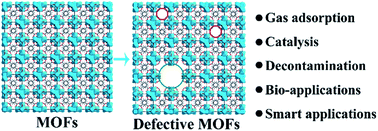Synthesis, characterization and application of defective metal–organic frameworks: current status and perspectives
Abstract
Defects are now recognized to be a useful tool in tailoring the properties of metal–organic frameworks (MOFs). The introduction of missing linker and cluster defects into MOFs provides additional active sites, optimizes the acidity/basicity, improves the conductivity, tailors mechanical responses and creates more pore space to enhance diffusion and mass transfer in MOFs. Structural defects in MOFs have been demonstrated to be beneficial in areas such as catalysis, decontamination, bio-applications, adsorption, separation, energy storage, energy conversion, electronics, magnetics, optical functional materials and others. Defective MOFs are also excellent model materials for the fundamental study of defect chemistry. In this review, we provide a general overview of the commonly available methods that are feasible for the creation and characterization of structural defects in MOF materials. Additionally, recent studies on various applications of defective MOFs are highlighted, aiming to provide new insights into the design and introduction of structural defects to synthesize MOF materials with high performance and to promote the wide application of defective MOFs in various fields. Challenges and future perspectives on defect engineering of MOFs are also addressed.



 Please wait while we load your content...
Please wait while we load your content...